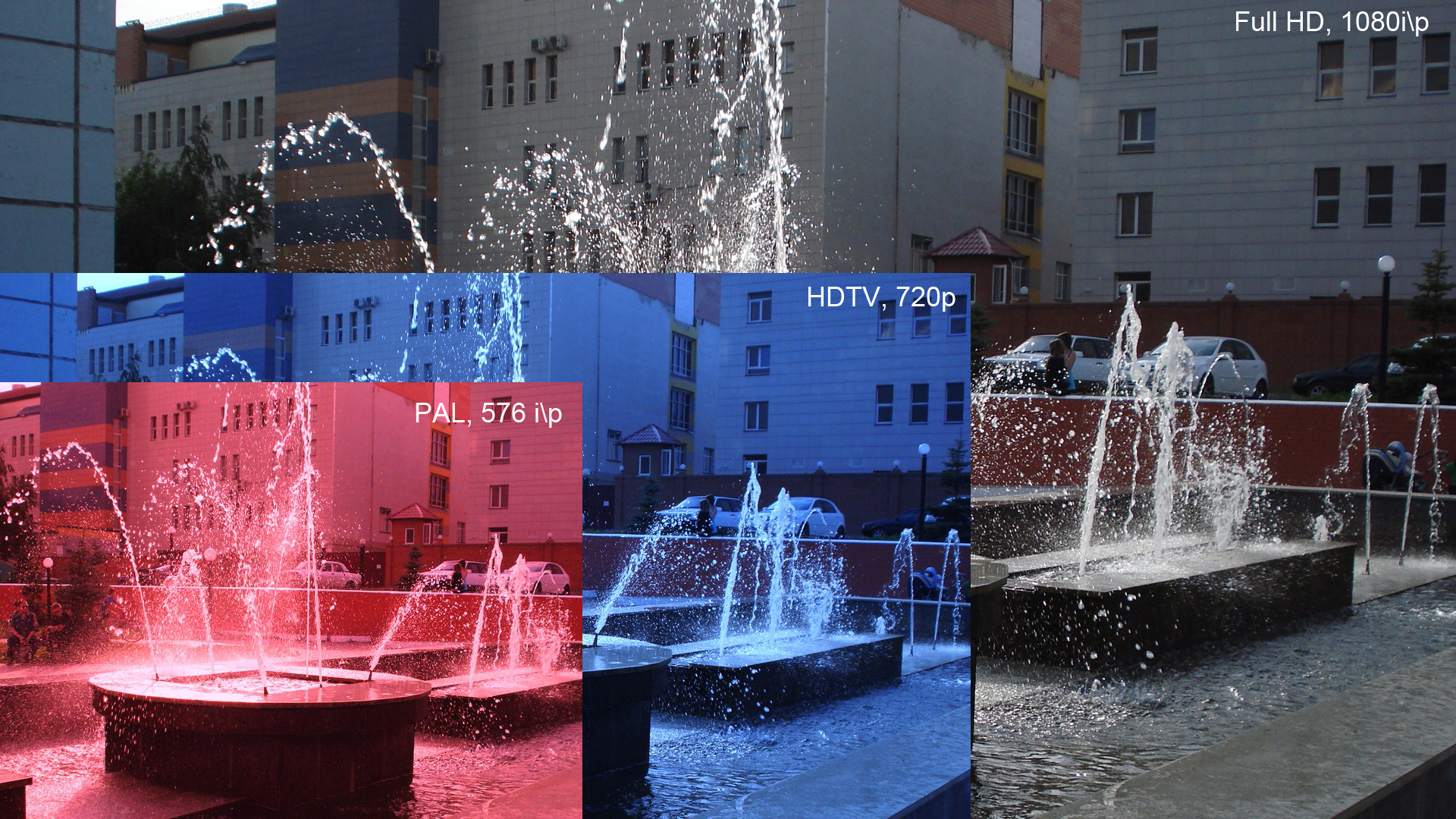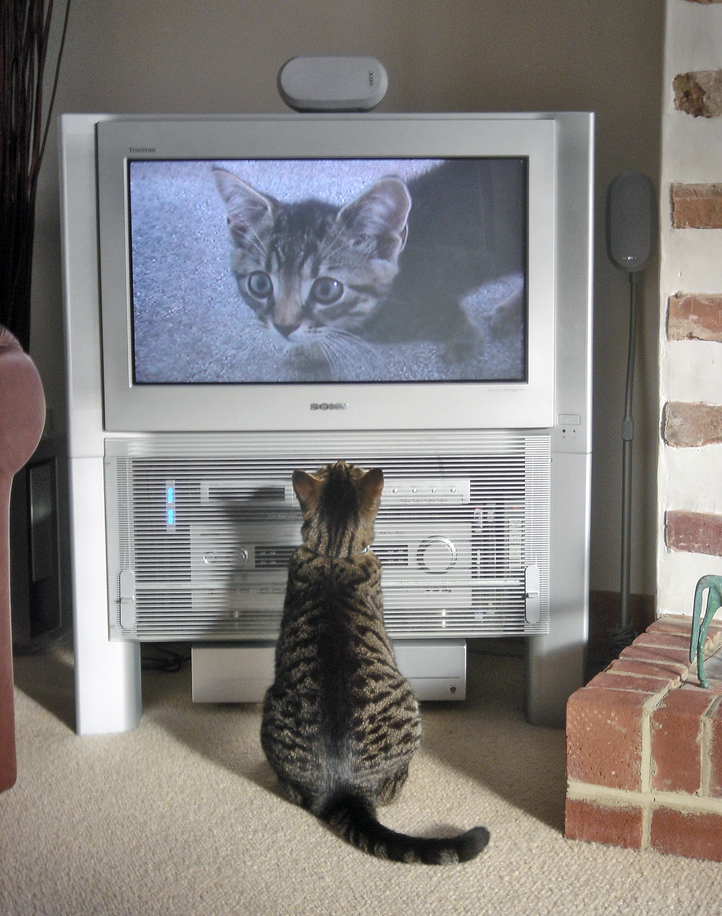|
1080p
1080p (1920 × 1080 progressively displayed pixels; also known as Full HD or FHD, and BT.709) is a set of HDTV high-definition video modes characterized by 1,920 pixels displayed across the screen horizontally and 1,080 pixels down the screen vertically; the ''p'' stands for progressive scan, ''i.e.'' non- interlaced. The term usually assumes a widescreen aspect ratio of 16:9, implying a resolution of 2.1 megapixels. It is often marketed as Full HD or FHD, to contrast 1080p with 720p resolution screens. Although 1080p is sometimes referred to as 2K resolution (meaning having a horizontal resolution of approximately 2,000 pixels), other sources differentiate between 1080p and (true) 2K resolution. 1080p video signals are supported by ATSC standards in the United States and DVB standards in Europe. Applications of the 1080p standard include television broadcasts, Blu-ray Discs, smartphones, Internet content such as YouTube videos and Netflix TV shows and movi ... [...More Info...] [...Related Items...] OR: [Wikipedia] [Google] [Baidu] |
HD Ready
HD ready is a certification program introduced in 2005 by EICTA (European Information, Communications and Consumer Electronics Technology Industry Associations), now DigitalEurope, DIGITALEUROPE. HD ready minimum native resolution is 720 rows in widescreen ratio. There are currently four different labels: "HD ready", "HD TV", "HD ready 1080p", "HD TV 1080p". The logos are assigned to television equipment capable of certain features. In the United States, a similar "HD Ready" term usually refers to any display that is capable of accepting and displaying a high-definition signal at either 720p, 1080i or 1080p using a component video or digital input, but does not have a built-in High-definition television, HD-capable tuner. History The "HD ready" certification program was introduced on January 19, 2005. The labels and relevant specifications are based on agreements between over 60 broadcasters and manufacturers of the European HDTV Forum at its second session in June 2004, held at ... [...More Info...] [...Related Items...] OR: [Wikipedia] [Google] [Baidu] |
High-definition Video
High-definition video (HD video) is video of higher resolution and quality than standard-definition. While there is no standardized meaning for ''high-definition'', generally any video image with considerably more than 480 vertical scan lines (North America) or 576 vertical lines (Europe) is considered high-definition. 480 scan lines is generally the minimum even though the majority of systems greatly exceed that. Images of standard resolution captured at rates faster than normal (60 frames/second North America, 50 fps Europe), by a high-speed camera may be considered high-definition in some contexts. Some television series shot on high-definition video are made to look as if they have been shot on film, a technique which is often known as filmizing. History The first electronic scanning format, 405 lines, was the first ''high definition'' television system, since the mechanical systems it replaced had far fewer. From 1939, Europe and the US tried 605 and 441 lines until, i ... [...More Info...] [...Related Items...] OR: [Wikipedia] [Google] [Baidu] |
Smartphone
A smartphone is a mobile phone with advanced computing capabilities. It typically has a touchscreen interface, allowing users to access a wide range of applications and services, such as web browsing, email, and social media, as well as multimedia playback and Streaming media, streaming. Smartphones have built-in cameras, GPS navigation, and support for various communication methods, including voice calls, text messaging, and internet-based messaging apps. Smartphones are distinguished from older-design feature phones by their more advanced hardware capabilities and extensive mobile operating systems, access to the internet, business applications, Mobile payment, mobile payments, and multimedia functionality, including music, video, mobile gaming, gaming, Internet radio, radio, and Mobile television, television. Smartphones typically feature MOSFET, metal–oxide–semiconductor (MOS) integrated circuit (IC) chips, various sensors, and support for multiple wireless communicati ... [...More Info...] [...Related Items...] OR: [Wikipedia] [Google] [Baidu] |
Blu-ray
Blu-ray (Blu-ray Disc or BD) is a digital optical disc data storage format designed to supersede the DVD format. It was invented and developed in 2005 and released worldwide on June 20, 2006, capable of storing several hours of high-definition video ( HDTV 720p and 1080p). The main application of Blu-ray is as a medium for video material such as feature films and for the physical distribution of video games for the PlayStation 3, PlayStation 4, PlayStation 5, Xbox One, and Xbox Series X. The name refers to the blue laser used to read the disc, which allows information to be stored at a greater density than is possible with the longer-wavelength red laser used for DVDs, resulting in an increased capacity. The polycarbonate disc is in diameter and thick, the same size as DVDs and CDs. Conventional (or "pre-BDXL") Blu-ray discs contain 25 GB per layer, with dual-layer discs (50GB) being the industry standard for feature-length video discs. Triple-layer discs (10 ... [...More Info...] [...Related Items...] OR: [Wikipedia] [Google] [Baidu] |
Interlaced Video
Interlaced video (also known as interlaced scan) is a technique for doubling the perceived frame rate of a video display without consuming extra Bandwidth (signal processing), bandwidth. The interlaced signal contains two field (video), fields of a video frame captured consecutively. This enhances motion perception to the viewer, and reduces flicker (screen), flicker by taking advantage of the characteristics of the human visual system. This effectively doubles the time resolution (also called ''temporal resolution'') as compared to non-interlaced footage (for frame rates equal to field rates). Interlaced signals require a display that is natively capable of showing the individual fields in a sequential order. cathode-ray tube, CRT displays and ALiS plasma displays are made for displaying interlaced signals. Interlaced scan refers to one of two common methods for "painting" a video image on an electronic display screen (the other being progressive video, progressive scan) by sc ... [...More Info...] [...Related Items...] OR: [Wikipedia] [Google] [Baidu] |
High-definition Television
High-definition television (HDTV) describes a television or video system which provides a substantially higher image resolution than the previous generation of technologies. The term has been used since at least 1933; in more recent times, it refers to the generation following standard-definition television (SDTV). It is the standard video format used in most broadcasts: Terrestrial television, terrestrial broadcast television, cable television, satellite television. Formats HDTV may be transmitted in various formats: * 720p (): 921,600 pixels * 1080i () interlaced scan: 1,036,800 pixels (≈1.04Mpx). * 1080p () progressive scan: 2,073,600 pixels (≈2.07Mpx). ** Some countries also use a non-standard CTA resolution, such as : 777,600 pixels (≈0.78Mpx) per field or 1,555,200 pixels (≈1.56Mpx) per frame When transmitted at two megapixels per frame, HDTV provides about five times as many pixels as SD (standard-definition television). The increased resolution provides for a cl ... [...More Info...] [...Related Items...] OR: [Wikipedia] [Google] [Baidu] |
Display Resolution
The display resolution or display modes of a digital television, computer monitor, or other display device is the number of distinct pixels in each dimension that can be displayed. It can be an ambiguous term especially as the displayed resolution is controlled by different factors in cathode-ray tube (CRT) displays, flat-panel displays (including liquid-crystal displays) and projection displays using fixed picture-element (pixel) arrays. It is usually quoted as ', with the units in pixels: for example, ' means the width is 1024 pixels and the height is 768 pixels. This example would normally be spoken as "ten twenty-four by seven sixty-eight" or "ten twenty-four by seven six eight". One use of the term ''display resolution'' applies to fixed-pixel-array displays such as plasma display panels (PDP), liquid-crystal displays (LCD), Digital Light Processing (DLP) projectors, AMOLED, OLED displays, and similar technologies, and is simply the physical number of columns and rows of pi ... [...More Info...] [...Related Items...] OR: [Wikipedia] [Google] [Baidu] |
Deinterlacing
Deinterlacing is the process of converting interlaced video into a non-interlaced or Progressive scan, progressive form. Interlaced video signals are commonly found in analog television, VHS, Laserdisc, digital television (HDTV) when in the 1080i format, some DVD titles, and a smaller number of Blu-ray discs. An interlaced video frame consists of two Field (video), fields taken in sequence: the first containing all the odd lines of the image, and the second all the even lines. Analog television employed this technique because it allowed for less transmission bandwidth while keeping a high frame rate for smoother and more life-like motion. A non-interlaced (or progressive scan) signal that uses the same bandwidth only updates the display half as often and was found to create a perceived flicker or stutter. CRT-based displays were able to display interlaced video correctly due to their complete analog nature, blending in the alternating lines seamlessly. However, since the early 20 ... [...More Info...] [...Related Items...] OR: [Wikipedia] [Google] [Baidu] |
Netflix
Netflix is an American subscription video on-demand over-the-top streaming service. The service primarily distributes original and acquired films and television shows from various genres, and it is available internationally in multiple languages. Launched in 2007, nearly a decade after Netflix, Inc. began its pioneering DVD-by-mail movie rental service, Netflix is the most-subscribed video on demand streaming media service, with 301.6 million paid memberships in more than 190 countries as of 2025. By 2022, "Netflix Original" productions accounted for half of its library in the United States and the namesake company had ventured into other categories, such as video game publishing of mobile games through its flagship service. As of 2025, Netflix is the 18th most-visited website in the world, with 21.18% of its traffic coming from the United States, followed by the United Kingdom at 6.01%, Canada at 4.94%, and Brazil at 4.24%. History Launch as a mail-based renta ... [...More Info...] [...Related Items...] OR: [Wikipedia] [Google] [Baidu] |
Progressive Scan
Progressive scanning (alternatively referred to as noninterlaced scanning) is a format of displaying, storing, or transmitting moving images in which all the lines of each frame are drawn in sequence. This is in contrast to interlaced video used in traditional analog television systems where only the odd lines, then the even lines of each frame (each image called a video field) are drawn alternately, so that only half the number of actual image frames are used to produce video. The system was originally known as "sequential scanning" when it was used in the Baird 240 line television transmissions from Alexandra Palace, United Kingdom in 1936. It was also used in Baird's experimental transmissions using 30 lines in the 1920s.Burns, R.W. ''John Logie Baird, Television Pioneer'', Herts: The Institution of Electrical Engineers, 2000. 316. Progressive scanning became universally used in computer screens beginning in the early 21st century. Interline twitter This rough animatio ... [...More Info...] [...Related Items...] OR: [Wikipedia] [Google] [Baidu] |
2K Resolution
2K resolution is a generic term for display devices or content having a horizontal resolution of approximately 2,000 pixels. In the movie projection industry, Digital Cinema Initiatives Digital Cinema Initiatives, LLC (DCI) is a consortium of major motion picture studios, formed to establish specifications for a common systems architecture for digital cinema systems. The organization was formed in March 2002 by Metro-Goldwyn- ... is the dominant standard for 2K output and defines a 2K format with a resolution of . For television and consumer media, the dominant resolution in the same class is , but in the cinema industry this is generally referred to as HD and distinguished from the various 2K cinema formats. Resolutions Standards and terminology In the cinematography industry, 2K resolution traditionally refers to a digital scan of 35mm film with a resolution around 2000 pixels wide. Typically this is done at , but the exact dimensions vary based on the aspect rati ... [...More Info...] [...Related Items...] OR: [Wikipedia] [Google] [Baidu] |
Digital Camera
A digital camera, also called a digicam, is a camera that captures photographs in Digital data storage, digital memory. Most cameras produced today are digital, largely replacing those that capture images on photographic film or film stock. Digital cameras are now widely incorporated into mobile devices like smartphones with the same or more capabilities and features of dedicated cameras. High-end, high-definition dedicated cameras are still commonly used by professionals and those who desire to take higher-quality photographs. Digital and digital movie cameras share an optical system, typically using a Camera lens, lens with a variable Diaphragm (optics), diaphragm to focus light onto an image pickup device. The diaphragm and Shutter (photography), shutter admit a controlled amount of light to the image, just as with film, but the image pickup device is electronic rather than chemical. However, unlike film cameras, digital cameras can display images on a screen immediately afte ... [...More Info...] [...Related Items...] OR: [Wikipedia] [Google] [Baidu] |







